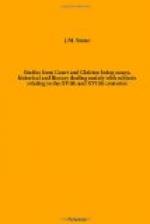For more than a century the column apparently lay where it fell, on the site of what had once been the altar of the church, and was made to serve as a bench for members of the congregation to sit upon.
In 1722, Pennant saw it still lying inside the church, but soon after this, better accommodation being required for the congregation, it was turned out into the churchyard to make room for modern improvements! Here it suffered greatly from repeated mutilations, the churchyard being then nearly unenclosed.
In 1802, the weather-cock of opinion having again veered round, the then incumbent, Dr. Duncan, desiring to preserve this “object of superstition,” now become a precious relic, had the main shaft removed to his newly-enclosed manse garden where it remained till 1887, when an apse being added to the church, the Cross was again enclosed within the building. Meanwhile two other fragments had entirely disappeared. The cross-beam has never been recovered,* but the top-stone suddenly reappeared in the following curious manner:
* Transverse arms were supplied in 1823. A. S. Cook, The Dream of the Rood.
A poor man and his wife having died within a few days of each other, it was decided to bury them both in one grave. For this it was necessary to dig deeper than usual, and in doing so, the grave-digger came upon an obstacle which proved to be a block of red sandstone with sculptured figures upon it. This block was found to be the missing top-stone of the Cross.
One point still needs explanation. When Pennant saw the Cross in the early part of the eighteenth century, before the buried fragment had been excavated, it measured 2o feet in height. At the present day, although the top has been replaced, the height of the column does not exceed 17 feet 6 inches, a circumstance that can only be accounted for by the supposition that the obelisk may have sunk several feet into the ground in the interval.
The spirit that breathes in The Dream of the Rood is strongly imbued with national elements. The doctrine and sentiments are strictly Catholic, but the poem is at the same time an epitome of what St. Cuthbert and the monks of Lindisfarne, the royal Abbess Hilda, Caedmon, and now it appears Cynewulf also had been long doing for Northumbria, in taking what was grand and heroic in the old heathen traditions, and leading up through them to Christianity. But if this influence can be distinctly traced in the runes on the Ruthwell Cross, yet another element is seen in its ornamentation, which carries us back to the Christian tombs in the Roman catacombs where its prototypes are to be found.




